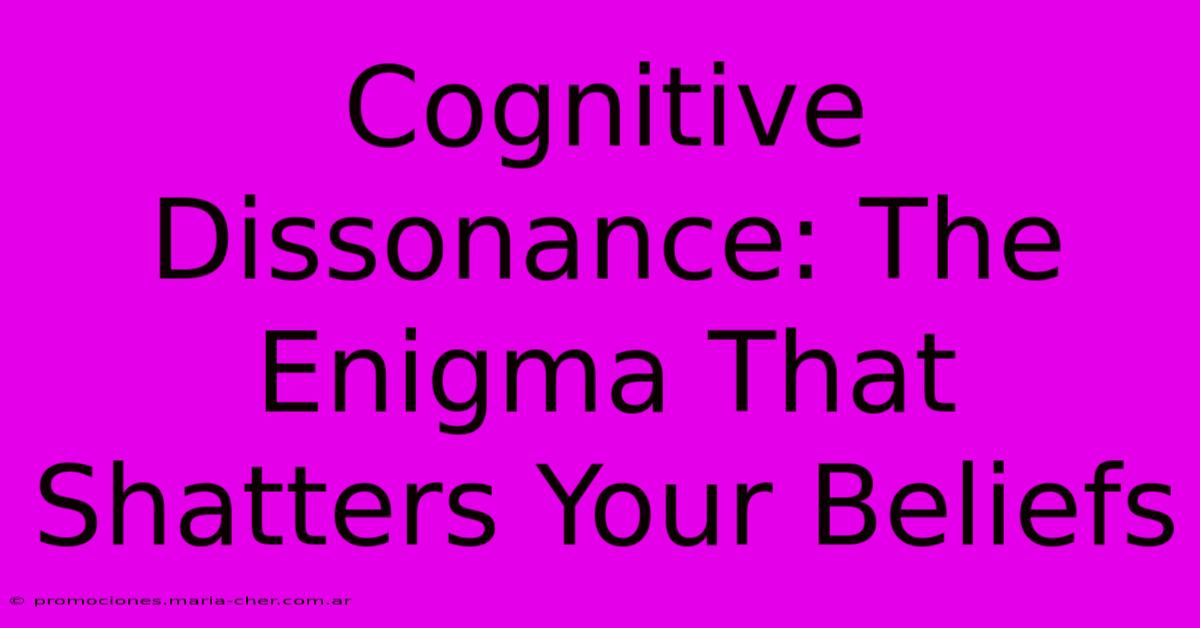Cognitive Dissonance: The Enigma That Shatters Your Beliefs

Table of Contents
Cognitive Dissonance: The Enigma That Shatters Your Beliefs
We all strive for internal consistency. A harmonious state where our beliefs, attitudes, and actions align perfectly. But what happens when this delicate balance is disrupted? When we find ourselves holding conflicting ideas or acting in ways that contradict our values? This is where cognitive dissonance steps in, a psychological phenomenon that can significantly impact our thoughts, feelings, and behaviors. This article delves into the fascinating world of cognitive dissonance, exploring its causes, effects, and how to manage its unsettling influence.
Understanding Cognitive Dissonance: The Conflict Within
Cognitive dissonance, a term coined by Leon Festinger, refers to the mental discomfort experienced by a person who holds two or more contradictory beliefs, ideas, or values. This discomfort arises from the psychological tension created when our actions clash with our self-perception or deeply held convictions. It's that unsettling feeling of unease, that nagging sense that something isn't quite right. Think of it as your brain's internal alarm system, signaling an inconsistency that needs resolving.
Examples of Cognitive Dissonance:
- The smoker: Knowing smoking is harmful to health while continuing to smoke creates a significant dissonance.
- The environmentalist driving a gas-guzzling SUV: A commitment to environmental protection clashes with the environmental impact of their vehicle choice.
- The ethical shopper buying products from a company with questionable labor practices: The desire for ethical consumption conflicts with the reality of supporting potentially exploitative practices.
The intensity of the dissonance depends on several factors, including:
- The importance of the conflicting beliefs: The more significant the beliefs involved, the stronger the dissonance.
- The number of conflicting beliefs: Multiple conflicting beliefs amplify the discomfort.
- The perceived control over the situation: If you feel you have little control, dissonance may be more intense.
How We Resolve Cognitive Dissonance: Reducing the Tension
When faced with cognitive dissonance, we're not passively accepting the discomfort. Our minds are actively working to reduce this tension and restore internal harmony. This is achieved through several mechanisms:
1. Changing our beliefs or attitudes:
This is the most direct approach. Perhaps the smoker decides to quit, accepting the health risks and modifying their belief about smoking's acceptability.
2. Changing our behavior:
The environmentalist might opt for a more fuel-efficient vehicle to align their actions with their environmental values.
3. Adding new cognitions to justify the behavior:
The ethical shopper might convince themselves that the company is making efforts to improve their practices or that the price point justifies the compromise. This involves rationalization and minimizing the negative aspects.
4. Downplaying the importance of the conflicting beliefs:
The smoker might minimize the health risks or focus on the enjoyment they derive from smoking, thereby reducing the weight of the conflicting information.
5. Avoiding dissonant information:
This involves selectively choosing information that reinforces existing beliefs and avoiding information that challenges them. This can lead to confirmation bias.
The Power of Cognitive Dissonance in Persuasion
Understanding cognitive dissonance can be a powerful tool in persuasion. Techniques like "foot-in-the-door" (making a small request followed by a larger one) leverage this phenomenon. By initially agreeing to a smaller request, individuals reduce dissonance by feeling more committed to the cause and are more likely to comply with subsequent, larger requests.
Managing Cognitive Dissonance in Your Life
Experiencing cognitive dissonance is a normal part of the human experience. However, prolonged exposure to significant dissonance can lead to stress, anxiety, and even depression. Here's how to manage it effectively:
- Self-reflection: Identify the sources of your dissonance.
- Honest self-assessment: Be willing to confront uncomfortable truths.
- Seek diverse perspectives: Challenge your own biases and assumptions.
- Embrace change: Be open to modifying beliefs or behaviors when necessary.
- Practice mindfulness: Increase self-awareness to identify dissonance early.
Cognitive dissonance is a compelling illustration of the human mind's complex mechanism for maintaining internal consistency. By understanding its workings, we can navigate this internal conflict more effectively and cultivate a more authentic and balanced self. The journey towards resolving cognitive dissonance is a journey towards greater self-awareness and personal growth.

Thank you for visiting our website wich cover about Cognitive Dissonance: The Enigma That Shatters Your Beliefs. We hope the information provided has been useful to you. Feel free to contact us if you have any questions or need further assistance. See you next time and dont miss to bookmark.
Featured Posts
-
Elevate Your Jewelry Collection With The Golden Glow Of Vermeil Necklaces
Feb 07, 2025
-
Unleash Your Inner Artist Design Your Own Saddle Stitched Wall Calendar
Feb 07, 2025
-
Checkmate Create An Invitation For A Chess Inspired Birthday Bonanza
Feb 07, 2025
-
Revolutionize Your Earring Game Discover The Magic Of Second Hole Piercings
Feb 07, 2025
-
Effortless Email Signature Makeover Free Transition Images To Elevate Your Brand
Feb 07, 2025
